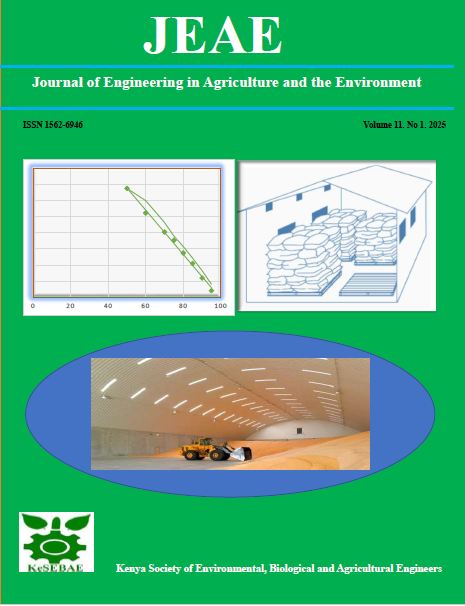Abstract
Poor storage systems lead to losses of up to 50% of stored grain. Grains are stored by various systems in the value chain, which include piles on the ground, bag storage in ware houses, on the cob storage in cribs and bulk storage in silos and bankers. The cost of storage depends on the duration and quantity of storage. This also dictates if construction or renting the same as viable. The BCR (Benefit Cost Ratio) between construction and renting in a large scale is 0.7261. Renting is cheaper in large scale. Cost of storing in bulk storage in a silo is $ 2.95 per tonne in a year and $0.497 per kg per annum in a bag storage. This paper discusses the technical and economic merits of the various grain storage systems and provided proposals for development of storage systems which will enhance food security in developing counties.
References
Agrios, C.A (1988). Pesticide in Tropical Pest Management. Insect Science and its. Application, 8: 731-736.
Albert J. M, Jean C. H. M, John. B (2006). Organizational Behaviour in a Global Context. Pg 116
Azu J (2002). Post-harvest loss reduction: OICI Tamales quick interventions for reducing food insecurity. Ghana, OICI International.
Babcock P.G (1976). Websters’ Third New International Dictionary. Springfield, Massachusetts: G&C. Meriam co.
Bishara, A.G. (1985): Interaction of Bin and Bulk Silo. Civil Engineering Department, Ohio State University.
Botta P (2015): Costs of Grain Storage. Grain Storage Specialist
Boucher, S. R., M. Carter. R, and Guirkinger. C (2008). “Risk Rationing and Wealth Effects in Credit Markets: Theory and Implications for Agricultural Development” American Journal of Agricultural Economics 90(2): 409–423.
Caswell, G. H (1981). Damaged to stored cowpea in the Northern Part of Nigeria. Samaru J. Agrc. Res. 1(1): 11-19.
Charles B, Hugo De Groote, Clare N.C and Rosemarie S (2011): Economic importance of different maize storage structures in Kenya. Aflacontrol Conference
Compton J.A.F (1992). Reducing losses in small farm grain storage in the topics: Chatham: NRI.
David B. F. (1999): Winter Wheat Production Manual
Davis S J, Noel D.G and William E. M (1995): Stored Grain Ecosystems
Doug B, Calen May-Tobin, Katherine L, and Sarah R (2011): The Root of the Problem. Small-Scale Farming and Shifting Cultivation
De Lucia, M. and Assennato, D (1994): Agricultural engineering in development post-harvest operations and management of foodgrains. FAO Agricultural Services Bulletin No. 93 Food and Agriculture Organization of the United Nations, Rome. Available online at http://www.fao.org/docrep/T0522E/T0522E00.htm. Accessed August 8, 2016.
D.W.Hall (1990): Handling and Storage of Food Grains in Tropical and Subtropical Areas. Rome
FAO (2016). Grain storage technologies-Evolution and trends in developing countries
FAO (2012). Report on Post-Harvest Management.
FAO. (1994): Grain Storage Techniques. Evolution and Trends in Developing Countries. Rome
FAO (1994). African experience in the improvement of post-harvest techniques. Synthesis Based on the Workshop held in Accra, Ghana, 4-8 July 1994 Agricultural Support Systems Div. Food and Agriculture Organization of the United Nations, Rome Italy
FAO. Corporate Document Respiratory. (1988): Farm Structures in Tropic Climates. Rome
Gary M (2010). Economics of grain storage-meeting market requirements. Grant Thorton UK
GRDC. Grains Research and Development Cooperation (2012). Grain storage facilities planning for efficiency and quality. Again industry guide.
GRDC. Grains Research and Development Cooperation (2013). Economics of on-farm grain storage: A grain industry guide.
GOK (1981). National Food security and National Policy. Sessional paper 4 of 1981.
Gumbe, L.O (1988): Prediction Equation for Loads in Grain Silos. C.I.G.R. Inter-Sections Symposium. Rural Technology for Agricultural Growth in Developing Countries.
Hall, D.W. (1970). Handling and storage of food grains in tropical and subtropical areas.pg 2-3.
Harris K.L and Lindblad C.J (2011). Post-harvest grain loss.
HGCA grain storage guide for cereals and oilseeds (2011). 3rd Edition.
Hodges.R, Marc.B and Rembold.F (2014). APHLIS-postharvest cereal losses in sub-saharan Afric, their estimation, assessment and reduction.
John F and Holmes S (2006). An analysis of grain storage bags, sealed grain silos and warehousing for storing grain.
Kimenju S.C and Hugo De Groote (2010). Economics analysis of alternative maize storage technologies in Kenya.
Klose D, Hendrie G and Noakes M (2009). Cereals foods and legume consumption by Australian children. Secondary analysis of the 2007 National Children’s Nutrition and Physical activity survey.
Komen. J.J, Mutoko C.M, Wanyama J.M, Rono S.C, Mose L.O (2010). Economics of post-harvest maize grain losses in Trans-Nzoia and Uasin Gishu District of North West Kenya. Kenya Agricultural Institute, Kitale.
Magan, N. and Aldred, D. (2007). "Post-Harvest Control Strategies: Minimizing Mycotoxins in the Food Chain." International Journal of Food Microbiology 119(1-2): 131-139.
Mac Y, Roy P, Steve K (2009). Economics of grain storage bags in the coastal Bend and Upper Gulf Cost of Texas. Farm assistance focus
Mrema. C.G, Gumbe.L.O, Chepete.H.J, and Agullo.J.O (2011): Rural Structures In the Tropics .Design and Development. Rome
Nduku, T M., De Groote, Hugo and Nzuma, J, M (2014): Comparative Analysis of Maize Storage Structures in Kenya. International Maize and Wheat Improvement Center.
Proctor D.L (1994). Grain storage technologies: Evolution and trends in developing countries.vol.109, FAO agricultural services bulletin no.109.GASCA-Group for assistance on system relating to grain after harvesting. Rome: Food and Agriculture organisation of the United Nations
Republic of Kenya (2004). Strategy for revitalizing agriculture 2004-2014. Nairobi, Kenya. Ministries of Agriculture, Livestock and Fisheries Development, and Cooperative Development and Marketing.
Rick H, Mark B, and Felix R (2014): Postharvest Cereal Losses in Sub Saharan Africa, Their Estimation, Assessment and Reduction
Rose M and Douglas H.J (2009). Corn husker Economics. University of Nebraska-Lincoln Extension
Republic of Kenya (2007). Kenya Vision 2030. A competitive and prosperous nation Nairobi. Kenya, Ministry of Planning and National Development in partnership, Kenya and Government of Finland.
Spantech (2016). Grain Storage.
USDA. United States Development of Agriculture (2016). World Agricultural Supply and demand estimates.
WB. World Bank (2015). Post-harvest loss in Sub-Saharan Africa.

This work is licensed under a Creative Commons Attribution 4.0 International License.
